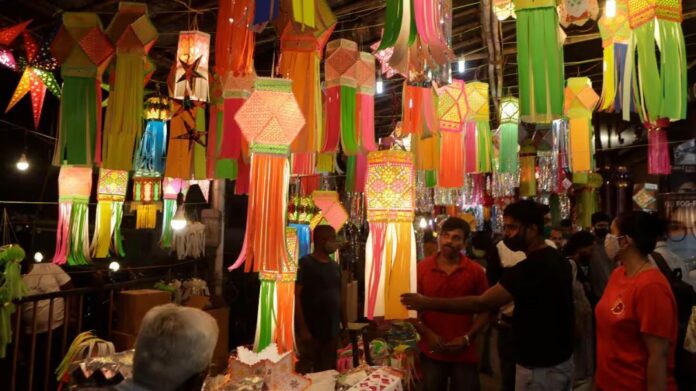Indian Traders Project Rs 4.25 Lakh Crore Turnover This Diwali Season, Says CAIT
With Diwali around the corner, the festive spirit has taken hold in markets across Delhi and throughout India. The Confederation of All India Traders (CAIT) anticipates a substantial economic boost, projecting a nationwide turnover of approximately Rs 4.25 lakh crore during the Diwali season. This projection underscores the season’s economic significance and the high expectations of retailers eager to capitalize on increased consumer spending.
CAIT’s Secretary General, Praveen Khandelwal, highlighted the immense preparations underway, particularly in Delhi, where the expected turnover could reach around Rs 75,000 crore. These projections reflect both consumer enthusiasm for the festival and a return to high foot traffic in physical markets. Khandelwal stated that markets in Delhi and beyond, including metropolitan centers, Tier 2 and Tier 3 cities, and smaller towns, are gearing up with elaborate decorations to create an inviting festive atmosphere. Traders are decorating shops with colorful lights, rangolis, and other traditional motifs to attract shoppers, fostering an immersive experience that appeals to families and groups celebrating Diwali.
To meet the expected demand surge, traders have been stocking a diverse range of goods, including popular festival items such as clothing, jewelry, electronics, mobile phones, home furnishings, puja items, deity idols, confectioneries, toys, and consumer durables. This variety not only caters to traditional Diwali shopping lists but also reflects evolving consumer preferences. Electronics and mobile phones, for example, have become popular Diwali purchases alongside traditional items like sweets, rangoli, and deity idols.
CAIT National President B.C. Bhartia emphasized that the festival season is more than just a time for celebration; it represents a critical opportunity for local businesses to drive significant sales. Bhartia highlighted the appeal of various discounts and promotional strategies designed to boost footfall, including popular “Buy One-Get One” offers and Diwali-specific discounts. These promotions are designed to draw shoppers away from e-commerce platforms and into local markets. This focus on promotions and discounts reveals the strategic planning by traders who recognize the challenges posed by the growth of online shopping. While e-commerce has reshaped consumer buying habits, Bhartia believes that the in-person shopping experience, especially during Diwali, holds an irreplaceable charm.
In addition to their marketing strategies, traders are also preparing for an influx of visitors by implementing special security and traffic arrangements. Given the heightened foot traffic expected in popular shopping areas, CAIT has requested that local police and administration ensure enhanced security and effective traffic control. Furthermore, trade associations are deploying additional private security personnel to manage the crowds and ensure a safe shopping environment for families. This attention to safety is crucial, as markets are expected to see high volumes of visitors, including elderly patrons and families with children, many of whom will be venturing out to celebrate Diwali in physical markets for the first time in several years.
The festive shopping spree highlights the broader impact of Diwali on India’s economy, where the holiday season accounts for a significant portion of annual retail revenue. The anticipated Rs 4.25 lakh crore in turnover marks a positive trend for India’s retail sector, reflecting not only a rebound in consumer confidence post-pandemic but also the economic resilience of small and medium businesses. The season’s impact is particularly vital for these businesses, which rely on the festival period to generate a large share of their annual income. The Diwali season has historically been a make-or-break period for many retailers, who often prepare months in advance to meet the demands of the festival.
Moreover, Diwali presents an opportunity for communities across the country to come together in shared celebrations. The vibrant marketplace activities, decorations, and festival-specific merchandise contribute to a sense of collective festivity that transcends individual purchases. By creating an inviting and festive market atmosphere, traders are encouraging a sense of normalcy and community engagement, which has been deeply missed in recent years.
To compete effectively with e-commerce, many physical retailers are adopting digital marketing techniques, including social media campaigns and localized online promotions. This hybrid approach allows local businesses to tap into the convenience of online visibility while preserving the unique appeal of in-store shopping. Many traders are leveraging platforms like WhatsApp, Instagram, and Facebook to showcase their products, announce special offers, and communicate directly with customers, fostering loyalty and a personal touch that online platforms may lack. This digital adaptation, coupled with traditional market practices, demonstrates how Indian retail is evolving to meet the needs of the modern consumer.
As the countdown to Diwali continues, the enthusiasm in India’s markets is palpable. Retailers, vendors, and artisans are all gearing up to make the most of this crucial time. CAIT’s forecast of a Rs 4.25 lakh crore turnover signifies the optimism among traders and the renewed vibrancy of India’s economy, driven by cultural celebrations and consumer spending. Whether through bustling marketplaces in Delhi or charming small-town bazaars, the Diwali shopping season is set to be a testament to India’s enduring spirit of celebration, community, and economic resilience.

